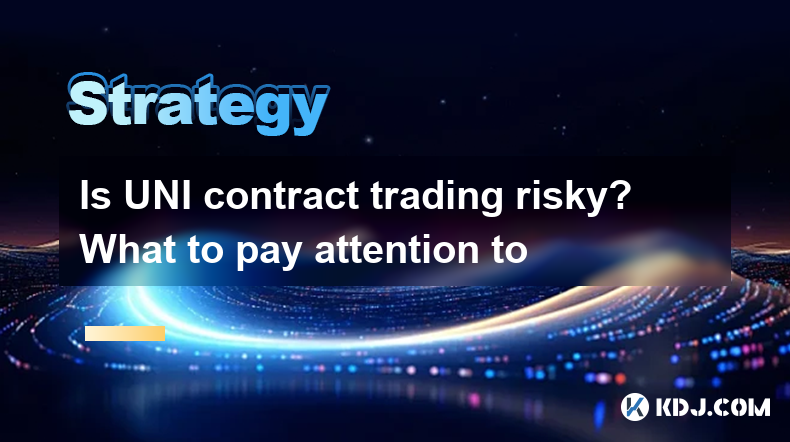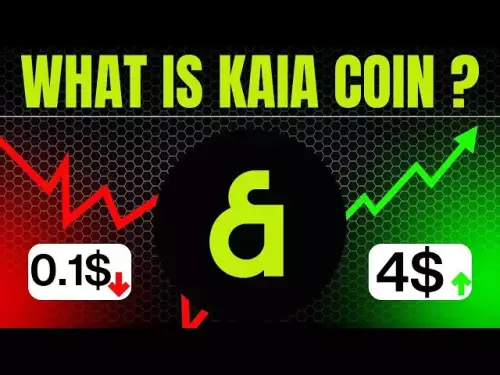-
 bitcoin
bitcoin $112715.707551 USD
-1.71% -
 ethereum
ethereum $4101.475385 USD
-3.01% -
 tether
tether $1.000644 USD
-0.02% -
 bnb
bnb $1207.619465 USD
-6.77% -
 xrp
xrp $2.501451 USD
-3.98% -
 solana
solana $202.947124 USD
-3.32% -
 usd-coin
usd-coin $1.000295 USD
0.04% -
 dogecoin
dogecoin $0.203884 USD
-4.47% -
 tron
tron $0.317154 USD
-1.72% -
 cardano
cardano $0.695009 USD
-4.43% -
 hyperliquid
hyperliquid $38.853961 USD
-8.23% -
 chainlink
chainlink $18.988674 USD
-4.64% -
 ethena-usde
ethena-usde $1.000233 USD
-0.03% -
 stellar
stellar $0.337050 USD
-3.63% -
 bitcoin-cash
bitcoin-cash $536.861728 USD
-1.28%
Is UNI contract trading risky? What to pay attention to
UNI contract trading carries risks like market volatility and leverage; traders should focus on market analysis, risk management, and platform reliability.
Apr 30, 2025 at 05:57 am

Is UNI contract trading risky? What to pay attention to
Trading UNI contracts, like any other cryptocurrency derivative, carries inherent risks that traders must be aware of and manage effectively. UNI, the governance token of the Uniswap decentralized exchange, is subject to the same market volatility and regulatory uncertainties as other cryptocurrencies. Understanding these risks and knowing what to pay attention to can help traders make more informed decisions. This article will delve into the specifics of UNI contract trading, highlighting key risks and important factors to consider.
Understanding UNI Contract Trading
UNI contract trading involves trading futures, options, or other derivative contracts based on the price of UNI. These financial instruments allow traders to speculate on the future price movements of UNI without owning the underlying asset. While this can offer potential for high returns, it also comes with significant risks.
Futures contracts are agreements to buy or sell UNI at a predetermined price on a specific date in the future. Options contracts, on the other hand, give the buyer the right, but not the obligation, to buy or sell UNI at a set price before the contract expires. Both types of contracts can be used for hedging or speculative purposes, but they require a deep understanding of market dynamics and risk management strategies.
Key Risks in UNI Contract Trading
One of the primary risks associated with UNI contract trading is market volatility. Cryptocurrency markets, including UNI, are known for their rapid price swings, which can lead to significant losses if not managed properly. Traders must be prepared for sudden price movements and have strategies in place to mitigate potential losses.
Another critical risk is leverage. Many UNI contracts are traded on margin, meaning traders can borrow funds to increase their position size. While leverage can amplify gains, it can also magnify losses, potentially leading to a complete wipeout of the trading account. It's essential for traders to use leverage cautiously and understand the implications of margin calls.
Liquidity risk is also a factor to consider. If the market for UNI contracts is not sufficiently liquid, traders may find it difficult to enter or exit positions at desired prices. This can result in slippage, where the executed price differs from the intended price, leading to unexpected losses.
Factors to Pay Attention to in UNI Contract Trading
When engaging in UNI contract trading, there are several factors that traders should pay close attention to. The first is market analysis. Understanding the broader market trends, as well as specific factors affecting UNI, such as platform developments or regulatory news, can help traders make more informed decisions.
Risk management is another crucial aspect. Traders should set clear stop-loss and take-profit levels to manage their exposure to potential losses. Additionally, diversifying trading strategies and not putting all capital into a single trade can help spread risk.
Platform reliability is also important. Trading UNI contracts on reputable and secure platforms can reduce the risk of technical issues or fraud. Traders should research the platforms they use, checking for user reviews, security features, and regulatory compliance.
Steps to Start Trading UNI Contracts
For those new to UNI contract trading, here are detailed steps to get started:
Choose a trading platform: Select a reputable exchange that offers UNI contract trading. Examples include Binance, Bybit, and FTX. Ensure the platform supports your desired type of contract (futures, options, etc.).
Create an account: Sign up for an account on the chosen platform. This typically involves providing personal information and completing a verification process.
Fund your account: Deposit funds into your trading account. Most platforms support deposits in cryptocurrencies like Bitcoin or Ethereum, as well as fiat currencies via bank transfer or credit card.
Understand the contract specifications: Before trading, familiarize yourself with the specific details of the UNI contracts offered on the platform, such as contract size, expiration date, and margin requirements.
Develop a trading strategy: Based on your market analysis and risk tolerance, develop a strategy for entering and exiting trades. This may involve technical analysis, fundamental analysis, or a combination of both.
Execute trades: Use the platform's trading interface to enter and manage your UNI contract positions. Monitor your trades closely and adjust your strategy as needed.
Manage risk: Implement risk management techniques, such as setting stop-loss orders and diversifying your trading portfolio, to protect your capital.
Regulatory Considerations
Trading UNI contracts is also subject to regulatory considerations. The legal status of cryptocurrency derivatives can vary significantly by jurisdiction, and traders must be aware of the rules and regulations that apply to their activities. Some countries have strict regulations on derivatives trading, while others may have more lenient or unclear policies.
Compliance with KYC (Know Your Customer) and AML (Anti-Money Laundering) requirements is a common regulatory obligation for trading platforms. Traders may need to provide identification and other personal information to comply with these regulations. Failure to adhere to regulatory requirements can result in account suspension or legal consequences.
Psychological Factors in UNI Contract Trading
Finally, traders should be mindful of the psychological factors involved in UNI contract trading. The high volatility and potential for rapid gains or losses can lead to emotional decision-making, which can be detrimental to trading performance. Maintaining discipline, sticking to a trading plan, and managing emotions are essential for long-term success in UNI contract trading.
Frequently Asked Questions
Q: Can I trade UNI contracts on all cryptocurrency exchanges?A: No, not all cryptocurrency exchanges offer UNI contract trading. It's important to check the offerings of each platform to ensure they support UNI futures, options, or other derivative products.
Q: What is the difference between perpetual futures and traditional futures contracts for UNI?A: Perpetual futures contracts for UNI do not have an expiration date, allowing traders to hold positions indefinitely. Traditional futures contracts, on the other hand, have a set expiration date, after which the contract must be settled or rolled over.
Q: How can I mitigate the risk of liquidation in UNI contract trading?A: To mitigate the risk of liquidation, traders can use stop-loss orders to automatically close positions at a predetermined price level. Additionally, maintaining a healthy account balance and not over-leveraging positions can help prevent liquidation.
Q: Are there any tools or resources that can help with UNI contract trading analysis?A: Yes, there are several tools and resources available for UNI contract trading analysis. These include trading platforms' built-in charting tools, third-party technical analysis software, and cryptocurrency news and analysis websites. Traders can also use social media and forums to stay updated on market sentiment and developments.
Disclaimer:info@kdj.com
The information provided is not trading advice. kdj.com does not assume any responsibility for any investments made based on the information provided in this article. Cryptocurrencies are highly volatile and it is highly recommended that you invest with caution after thorough research!
If you believe that the content used on this website infringes your copyright, please contact us immediately (info@kdj.com) and we will delete it promptly.
- MEXC's Explosive Growth: Trading Volume and Token Gains in Focus
- 2025-10-15 18:25:16
- Pudgy Penguins Price Prediction: Bull Flag Hints at Breakout!
- 2025-10-15 18:45:14
- GateToken Q3 2025 Onchain Destruction: Deflationary Strategy in Action
- 2025-10-15 18:45:14
- Chainlink (LINK): Super Bullish Signals Amidst Institutional Adoption
- 2025-10-15 18:25:16
- Coinbase's India Crypto Play: A Bullish Bet on CoinDCX and the Future of Digital Assets
- 2025-10-15 18:30:01
- Ripple's African Custody Network: A Game Changer?
- 2025-10-15 18:50:01
Related knowledge

Practical parameter settings for a Bitcoin multi-timeframe moving average system
Sep 18,2025 at 10:54pm
Optimizing Timeframe Combinations for Bitcoin Trading1. Selecting appropriate timeframes is crucial when building a multi-timeframe moving average sys...

How can I filter out false breakouts in Dogecoin high-frequency trading?
Sep 22,2025 at 01:00am
Understanding False Breakouts in Dogecoin Trading1. A false breakout occurs when Dogecoin's price appears to move beyond a defined support or resistan...

Techniques for identifying tops and bottoms in the Bitcoin on-chain NVT model
Sep 20,2025 at 07:54pm
Understanding the NVT Model in Bitcoin Analysis1. The Network Value to Transactions (NVT) ratio is often described as the 'P/E ratio' of the cryptocur...

What does the surge in open interest in Bitcoincoin futures mean?
Sep 20,2025 at 11:18pm
Understanding the Surge in Dogecoin Futures Open Interest1. A surge in open interest within Dogecoin futures indicates a growing number of active cont...

How can I use the Ethereum USDT premium to gauge market sentiment?
Sep 18,2025 at 11:55pm
Understanding the Ethereum USDT Premium1. The Ethereum USDT premium refers to the price difference between USDT (Tether) traded on Ethereum-based plat...

What should I do if Ethereum staking yields decline?
Sep 20,2025 at 06:18am
Understanding the Causes Behind Declining Ethereum Staking Yields1. The Ethereum network transitioned to a proof-of-stake consensus mechanism with the...

Practical parameter settings for a Bitcoin multi-timeframe moving average system
Sep 18,2025 at 10:54pm
Optimizing Timeframe Combinations for Bitcoin Trading1. Selecting appropriate timeframes is crucial when building a multi-timeframe moving average sys...

How can I filter out false breakouts in Dogecoin high-frequency trading?
Sep 22,2025 at 01:00am
Understanding False Breakouts in Dogecoin Trading1. A false breakout occurs when Dogecoin's price appears to move beyond a defined support or resistan...

Techniques for identifying tops and bottoms in the Bitcoin on-chain NVT model
Sep 20,2025 at 07:54pm
Understanding the NVT Model in Bitcoin Analysis1. The Network Value to Transactions (NVT) ratio is often described as the 'P/E ratio' of the cryptocur...

What does the surge in open interest in Bitcoincoin futures mean?
Sep 20,2025 at 11:18pm
Understanding the Surge in Dogecoin Futures Open Interest1. A surge in open interest within Dogecoin futures indicates a growing number of active cont...

How can I use the Ethereum USDT premium to gauge market sentiment?
Sep 18,2025 at 11:55pm
Understanding the Ethereum USDT Premium1. The Ethereum USDT premium refers to the price difference between USDT (Tether) traded on Ethereum-based plat...

What should I do if Ethereum staking yields decline?
Sep 20,2025 at 06:18am
Understanding the Causes Behind Declining Ethereum Staking Yields1. The Ethereum network transitioned to a proof-of-stake consensus mechanism with the...
See all articles


























![Staking ATH: How To Stake $ATH in October 2025 with 523% APY — [Step-By-Step Guide] Staking ATH: How To Stake $ATH in October 2025 with 523% APY — [Step-By-Step Guide]](/uploads/2025/10/15/cryptocurrencies-news/videos/staking-ath-stake-ath-october-apy-stepstep-guide/68eef94d80903_image_500_375.webp)















































